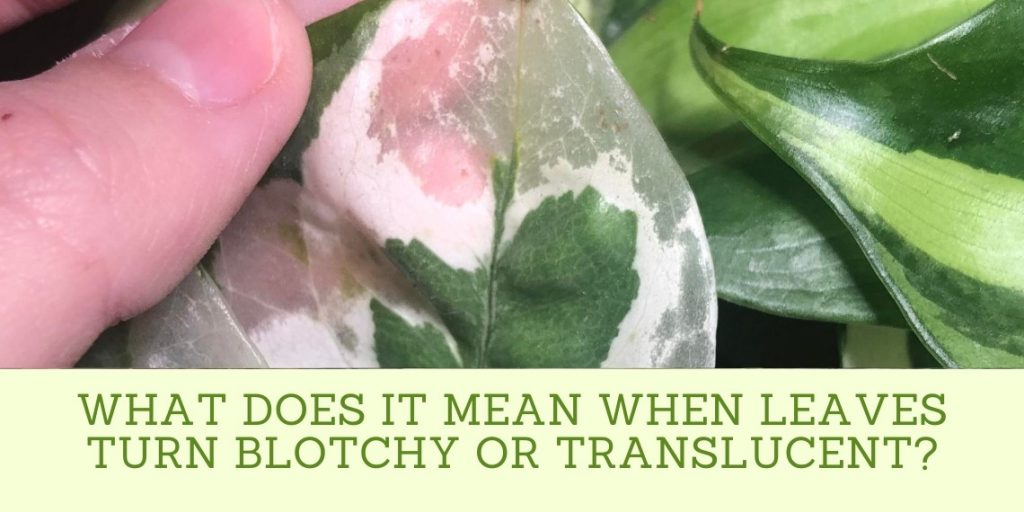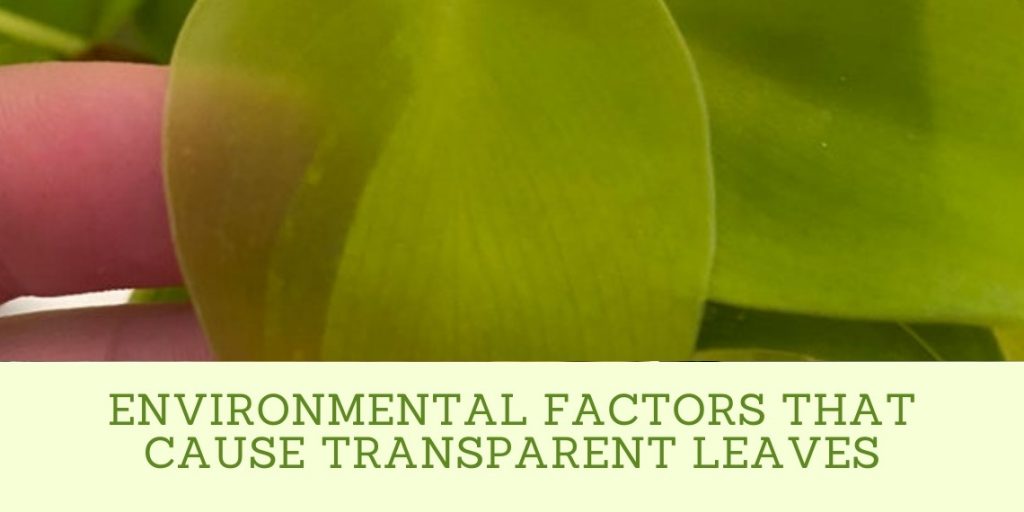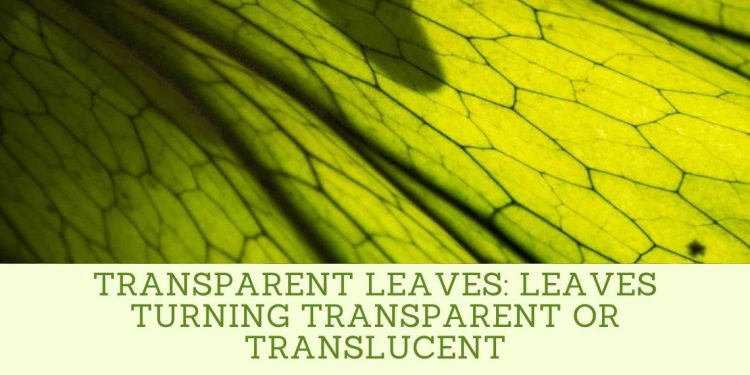Leaves under stress may take an interesting turn. When moisture is limited, as in drought conditions, leaves can actually become clear. During a plant’s photosynthetic process, water is used in the chemical reaction that makes plant food.
As water evaporates from leaves, it makes the cells more concentrated with dissolved compounds. But chlorophyll has trouble absorbing light through all this liquid, so photosynthesis slows down and eventually stops.
In effect, leaf cells desiccate below a certain point, those below the critical point die and those above it shrivel.
The leaf cells shrink as the water evaporates from them, but they can’t shrivel enough to stop photosynthesis completely. This occurs first in the palisade parenchyma of a leaf–the tiny “factory” cells located between upper and lower epidermal layers that have to support photosynthesis.
They’re the first cells affected by the lack of water because they’re actively involved in converting sunlight into food, rather than just making structural material like lignin or cellulose. When these cells shrink, you can see through them.
Leaves turn transparent or translucent as light shines through their mostly dead cells. Eventually, this affects the upper and lower epidermis as well and leaves become completely clear. When this happens to a whole plant, it’s called etiolation.
Why is Plant Leaves Turning Transparent?
The leaves of some plants are turning transparent. This happens because the plant is unable to produce or supply enough chlorophyll, which gives leaves their green color and protects them against harmful ultraviolet radiation.
If the plant doesn’t have enough chlorophyll, it will be more sensitive to diseases and insects. Humans can help prevent this by avoiding using too many pesticides, and plants that are at risk of being attacked by insects or diseases should be protected as soon as possible.
A lack of chlorophyll is often due to a lack of light, which the plant needs to produce. If the plant doesn’t have enough sun or if it’s shaded by other plants around it, this may induce a loss of chlorophyll.
On the contrary, if the plant is exposed to too much light, it may suffer from photoinhibition. This happens when plants are exposed to extreme levels of sunlight for more extended periods of time, and it makes photosynthesis less efficient over time.
If you notice that your plant leaves are turning transparent or translucent, it may be a sign that your plant is unhealthy and needs to be treated before it’s too late. Try changing its location or giving it a little more time in the sun, but not too much.
What Does it Mean When Leaves Turn Blotchy or Translucent?

It is pretty common for leaves to turn blotchy or translucent. In the fall, as leaves are dying and losing water, they will often change color. But this isn’t always a gradual process; sometimes, it can be sudden and dramatic.
Oftentimes, leaves turn blotchy because of pests, lack of nutrients, or diseases. That said, let’s explore more about what causes the foliage problems on your plants.
Pests
Pests are often to blame for leaves that turn transparent. Here are some common offenders:
Aphids
These tiny pests feed on the sap of plants, causing damage through the excretion of honeydew and distortion of plant tissue. Aphids can be bright green, red, black or brown, depending on the species.
Mealybugs
These critters are small, 1/10 to 1/5 inch long, oval-shaped and covered in a powdery white waxy coating. As they feed on the sap of plants, they cause discoloration and distortion of foliage.
Scale Insects
Scale insects form protective coverings that are hard at maturity. Damage is caused by the adult’s piercing mouthparts.
Spider Mites
These pests pierce the plant cells to feed, leaving behind a stippled or bleached effect on leaves. The damage is mainly caused by large populations feeding on a plant.
Spider mites also cause fruit trees to produce webbing, which can interfere with photosynthesis and make it harder for plants to get the nutrients they need.
Thrips
Thrips are another common pest that damages leaves by puncturing them with their mouthparts and using the fluids inside for food. The symptoms are dark or light spots on leaves honeydew excreted by the pests, which in turn attract sooty mold.
Whiteflies
The whiteflies are very tiny bugs. They fly, but they also cluster on the underside of leaves during their resting phase. You can identify them by their tiny wings that have a pearly appearance and their white scales that look like dandruff.
These suckers feed on sap from your plant’s leaves, causing yellow spots with halo symptoms, leaf drop, and stunted growth.
Lack of nutrients
If there are deficiencies in specific nutrients, such as nitrogen or phosphorus, then your plant will start to manifest symptoms of the deficiency. A nutrient deficiency in plants leads to poor growth and eventually affects the leaves of a plant.
Nitrogen Deficiency: A lack of nitrogen makes new foliage pale green or yellow, which results in the overall lightening of the leaf. At the same time, veins remain dark green.
This is because a plant requires a certain amount of nitrogen for growth, and the veins of a leaf continue using nutrients even if new foliage isn’t getting any.
Potassium Deficiency: A lack of potassium causes older leaves to turn yellow and dry up. As with nitrogen deficiency, new foliage may be pale green but remain healthy.
Zinc Deficiency: A lack of zinc causes a loss of chlorophyll in leaves, which then become yellow or white. Since this process is gradual, it’s harder to differentiate between the symptoms of a nutrient deficiency that is caused by an environmental factor versus one caused by pests or disease.
Some other signs of zinc deficiency are stunted growth, delayed flowering and even decreased yields.
Phosphorus Deficiency: When there’s a lack of phosphorus, older leaves turn dark green from the base up. A new layer of light-green leaves starts at the tips, but eventually, both the top and bottom of a leaf turn dark green.
Diseases
There are a variety of plant diseases that can cause blotchy and translucent leaves. For example, leaf rust appears as small orange or yellow pustules on the leaf surface, which turns brown with age.
This makes the leaves look dirty and dusty, resulting in a blotchy appearance after the pods begin to burst and release spores. When treating leaf rust, try using a fungicide spray containing copper-based ingredients to get rid of the infected leaves.
There are many other diseases that can cause blotchy and translucent leaves, such as powdery mildew, anthracnose, or gray mold. The tell-tale signs for these various leaf problems include:
- brown spots on leaves
- mottling and spotting of leaves
- gray mold appears as fuzzy, grayish-white growth on the underside of leaves
- dead or dying leaves that remain attached to branches
Leaves turning translucent is a common sight in the fall season. It usually means that your plants are suffering from certain issues.
By making sure that your plants are healthy and well-nourished, you can prevent any further problems caused by pests or diseases. Also, make sure to remove dead or dying leaves in order to avoid infections.
Environmental Factors That Cause Transparent Leaves

Some environmental factors that can cause leaves to turn transparent are:
Temperature Extremes
Often, the sudden change in temperature causes leaves to turn transparent. There are two separate groups of plants that have this problem: Plants for Tropical Regions (tropical) and Plants from Temperate zones (deciduous trees).
Tropical plants are often found near the equator and can’t tolerate any dramatic changes in temperature. Deciduous trees, on the other hand, are found in temperate regions of the world where there is a pronounced winter season and summer temperatures seem extreme to these plants.
Drought Conditions
When drought sets in and the soil stay dry for too long, the foliage will start turning transparent and eventually drop off. This is a common sight in plants that are native to an arid climate, but it can also affect plants from other regions if they aren’t watered regularly enough.
Excess Moisture
When leaves are exposed to excess moisture, they can turn transparent or develop a grayish-white waxy coating. This is a type of mold that can grow on any plant, and it spreads quickly, especially when humidity levels remain high.
It thrives in dark, damp places, so good air circulation is essential to prevent this from happening.
Low Humidity Levels
Leaves often turn transparent when humidity levels are too low, especially if plants are living in a home or other structure without air conditioning. This is because plants must take in water through their roots and transport it to all the cells of the plant through the xylem.
Transpiration through tiny pores on leaves helps cool them down as well as move water from root systems to leaf surfaces. When humidity levels are low, the xylem vessels that carry water become partially blocked by air bubbles (embolisms), which can cause parts of leaves to die.
Frost Damage
Freezing temperatures cause ice crystals to form between cells, which tears them apart and results in transparency. Plants can’t recover if they get this sort of damage. So, it’s essential to protect plants that are at risk by covering them or bringing them indoors when frost is expected.
Fungal Disease
Molds can also attack plant tissue, causing it to become transparent as the mold spreads. Leaves tend to turn yellow and then brown as fungal disease progresses.
When leaves turn transparent and collapse, the fungi spread quickly because there’s less leaf surface for air circulation, and pathogenic fungi don’t require much tissue to grow.
Treatment for Nutrient Disorder
If you are experiencing a nutrient deficiency, you can treat it by spraying the plant with a mixture of Epsom salt and water. Make sure to coat all surfaces of the plant, including the underside of the leaves. Repeat this treatment every two weeks until the problem is resolved.
A nutrient deficiency will cause leaves to turn transparent or translucent. Make sure you are using the correct type of fertilizer for your plant.
Some plants don’t need much nitrogen, while others require high amounts of phosphorous or potassium. Check the packaging for recommendations on usage and adjust accordingly.
Nutrient deficiency can also cause discoloration. One of the most common problems is a lack of chlorophyll.
Chlorophyll gives leaves their green color and serves as the site where photosynthesis occurs, so without it, plants become yellow or white. This is known as etiolation and usually occurs on new growth, such as shoots or young leaves.
While nutrient deficiencies can cause all sorts of problems, it is rare for them to be severe enough to kill your plant. Surviving leaves will eventually resume their normal coloring once the problem has been solved.
Treatment for Pest Problems
If you are having a pest problem, such as aphids, spider mites, or whiteflies, the Epsom salt spray can also help to get rid of these pests. Add one tablespoon of insecticidal soap to the Epsom salt solution and spray the plant thoroughly. The pests will die within one day of the spraying.
Spray once every two weeks until you are sure that the pest has been eliminated from your plant.
This is a great way to use Epsom salt on houseplants in order to get rid of pests without using harsh chemicals or pesticides that can be harmful to both pets and people alike.
Even after you have eliminated your pest problem, it is a good idea to continue the Epsom salt spray. One tablespoon of Epsom salt with one cup of water can also act as a fertilizer on your plants, which will help them grow healthy and strong.
Continue this treatment during the growing season. This will give your plant the nutrients it needs to grow and resist future pests.
Treatment for Environmental Problems
If your plant is suffering from an environmental problem, such as excess watering, heat stress, or drought, you will need to take different measures to help it recover.
For example, if your plant is in too much water, you will need to reduce the amount of water you are giving it and allow the soil to dry out slightly between waterings.
If your plant is under stress from the heat, you can move it to a cooler location or give it a misting. And if your plant is experiencing drought conditions, you can water it more frequently.
Leaves turning transparent or translucent is a warning sign that your plant is suffering from environmental stress. This can be a sign that it needs more water, less water, or cooler temperature conditions. If you see this symptom on your plant, take action immediately!
Your plant may look okay at first glance, but if you look closer, you will see that it’s not getting enough liquid or air. Transparent leaves can also be a sign that your plant is under too much water stress and its tissues are starting to dissolve away. If this is the case, stop watering immediately!
When you suspect that environmental factors are causing your plant’s leaves to turn transparent, increase the humidity around your plant by misting it regularly or by placing it on a tray of moist pebbles.
Increase the humidity around your plant to about 50 percent, and avoid exposing it to low temperatures while making the changes to its environment.
In rare cases, plants can have blocked stomata which results in loss of water from the leaves due to transpiration. In this case, immediately remove any mulch around the plant’s base, and increase the humidity around it.
The Bottom Line
The best way to prevent leaves from turning transparent is by providing plants with the appropriate environment and care.
This symptom often occurs in tandem with other ones. Therefore, it’s crucial to ensure that plants don’t get overwatered or have too little water, receive enough sunlight and have proper air circulation.
Whenever possible, buy plants from reputable sources and only repot indoor plants every few years because this can stress them out. If there’s a pest infestation of any kind, get rid of that problem before proceeding with treatment or prevention.
If leaves appear transparent and the plant is receiving the proper amount of sun and water, it may be receiving too much fertilizer. Leaves turning transparent or translucent is an issue that’s easily avoidable if you give plants what they need to thrive.


